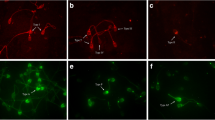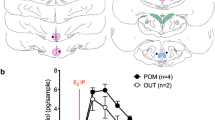Abstract
Specific binding sites for testosterone have been detected in three compartments of olfactory tissue from brown and rainbow trout. Binding of3H-testosterone to the membrane fraction of olfactory tissue is of high affinity (Kd = 0.5–1.9 nM) and limited capacity (Nmax = 30–60 fmol mg+1 protein). Binding is reversible, and is eliminated by protease treatment. The membrane binding site exhibits a high degree of ligand specificity; 11β-hydroxytestosterone, 11-ketotestosterone, 17α-hydroxyprogesterone, 17α,20β-dihydroxy-4-pregnen-3-one, cortisol, and estradiol-17β all fail to displace testosterone at 20-fold excess while testosterone itself competes successfully. These attributes are consistent with the presence of specific steroid receptor proteins. Binding of testosterone within the cytosol is of moderate affinity (Kd = 9.0–23.0 nM) and high capacity (Nmax = 0.5–2.9 pmol mg+1 protein) and is more readily displaced by a number of steroid competitors than is the case for the membrane site. The rate of association and dissociation of testosterone from the cytosolic binding site is markedly more rapid than the equivalent processes in the membrane fraction. Binding of testosterone to the nuclear extract is of high affinity (Kd ∼3.0 nM) and limited capacity (Nmax ∼50 fmol mg+1 protein).
There are no substantial differences between species or between sexes in the affinity or capacity of testosterone-binding sites in nuclear extract or membrane fraction. However, cytosolic testosterone-binding sites are three- to four-fold more abundant in rainbow trout than in brown trout, and female rainbow trout have more cytosolic binding sites than male rainbow trout, but a lower affinity for testosterone than male sites.
Preliminary evidence supports the involvement of the membrane-associated testosterone-binding site in olfactory processes. Rainbow trout display an EOG response to testosterone at a concentration (≥ 10+9 M) which is consistent with the equilibrium dissociation constant (Kd) of the membrane-associated testosterone-binding site. Binding of3H-testosterone to the membrane-associated site shows a pH dependency which is comparable to the effects of pH on the EOG response to testosterone in intact fish. The attributes of the intracellular testosterone-binding sites are common to testosterone receptors in other fish tissues which are known androgen target tissues. This suggests that the development and/or function of salmonid olfactory tissue may be susceptible to influence by endogenous testosterone.
Similar content being viewed by others
References cited
Bass, A.H., Segil, N. and Kelley D.B. 1986. Androgen binding in the brain and electric organ of a mormyrid fish. J. Comp. Physiol. A 159: 535–544.
Baynes, S.M. and Scott, A.P. 1985. Seasonal variations in parameters of milt production and in plasma concentration of sex steroids of male rainbow trout (Salmo gairdneri). Gen. Comp. Endocrinol. 57: 150–160.
Bjerselius, R., Olsen, K.H. and Zheng, W. 1995a. Behavioural and endocrinologic responses of mature male goldfish to the sex pheromone 17α,20β-dihydroxy-4-pregnen-3-one in the water. J. Exp. Biol. 198: 747–754.
Bjerselius, R., Olsen, K.H. and Zheng, W. 1995b. Endocrine, gonadal and behavioural responses of male crucian carp to the hormonal pheromene 17α,20β-dihydroxy-4-pregnen-3-one. Chemical Senses 20: 221–230.
Blackmore, P.F. 1993. Rapid non-genomic actions of progesterone stimulate Ca2+ influx and the acrosome reaction in human sperm. Cell. Sign. 5: 531–538.
Brann, D.W., Hendry, L.B. and Mahesh, V.B. 1995. Emerging diversities in the mechanism of action of steroid hormones. J. Steroid Biochem. Mol. Biol. 52: 113–133.
Cardwell, J.R., Stacey, N.E., Tan, E.S.P., McAdam, D.S.O. and Lang, S.L.C. 1995. Androgen increases olfactory receptor response to a vertebrate sex pheromone. J. Comp. Physiol. A 176: 55–61.
Evans, D.H. and Hara, T.J. 1985. The characteristics of the electro-olfactogram (EOG): its recovery following olfactory nerve section in rainbow trout (Salmo gairdneri). Brain Res. 330: 65–75.
Farbman, A.I. 1994. The cellular basis of olfaction. Endeavour 18: 2–8.
Grote, H., Ioannou, I., Voigt, J. and Sekeris, C.E. 1993. Localization of the glucocorticoid receptor in rat liver cells: evidence for plasma membrane bound receptor. Int. J. Biochem. 25: 1593–1599.
Hara, T.J. 1992. Mechanisms of olfaction,In Fish Chemoreception. pp. 150–170. Edited by T.J. Hara. Chapman and Hall, London.
Haukkamaa, M. 1987. Membrane-associated steroid hormone receptors.In Steroid Hormone Receptors: Their Intracellular Localisation. pp. 155–169. Edited by C.R. Clark. Ellis Horwood, Chichester.
Horvat, A., Nikezić, G. and Martinović, J.V. 1995. Estradiol binding to synaptosomal plasma membranes of rat brain regions. Experientia 51: 11–15.
Hulme, E.C. 1990. Receptor binding studies, a brief outline.In Receptor Biochemistry. A Practical Approach. pp. 303–315. Edited by E.C. Hulme. IRL Press, Oxford.
Kitamura, S., Ogata, H. and Takashima, F. 1994. Olfactory responses of several species of teleost to F-prostaglandins. Comp. Biochem. Physiol. 107A: 463–467.
Konoplya, E.F. and Popoff, E.H. 1992. Identification of the classical androgen receptor in male rat liver and prostate cell plasma membranes. Int. J. Biochem. 24: 1979–1983.
Lambert, J.G.D. and Resink, J.W. 1991. Steroid glucuronides as male pheromones in the reproduction of the African catfishClarias gariepinus — a brief review. J. Steroid Biochem. Mol. Biol. 40: 549–556.
Liley, N.R., Olsén, K.H., Foote, C.J. and Van Der Kraak, G.J. 1993. Endocrine changes associated with spawning behaviour in male kokanee salmon (Oncorhynchus nerka) and the effects of anosmia. Horm. Behav. 27: 470–487.
Maneckjee, A., Idler, D.R. and Weisbart, M. 1991. Demonstration of putative membrane and cytosol steroid receptors for 17α,20β-dihydroxy-4-pregnen-3-one in brook troutSalvelinus fontinalis oocytes by photoaffinity labelling using synthetic progestin 17,21-dimethyl-19-nor-pregn-4,9-diene-3,20-dione (R5020). Fish Physiol. Biochem. 9: 123–135.
Moore, A. 1994. An electrophysiological study on the effects of pH on olfaction in mature male Atlantic salmon (Salmo salar) parr. J. Fish Biol. 45: 493–502.
Moore, A. and Scott, A.P. 1991. Testosterone is a potent odorant in precocious male Atlantic salmon (Salmo salar L.) parr. Phil. Trans. Roy. Soc. Lond. B 332: 241–244.
Moore, A. and Scott, A.P. 1992. 17α,20β-dihydroxy-4-pregnen-3-one 20-sulphate is a potent odorant in precocious male Atlantic salmon (Salmo salar L.) parr which have been pre-exposed to the urine of ovulated females. Proc. Roy. Soc. Lond. B 249: 205–209.
Moore, F.L., Orchinik, M. and Lowry, C. 1995. Functional studies of corticosterone receptors in neuronal membranes. Receptor 5: 21–28.
Newcombe, C. and Hartman, G. 1973. Some chemical signals in the spawning behaviour of rainbow trout (Salmo gairdneri). J. Fish. Res. Bd. Can. 30: 995–997.
Ogata, H., Kitamura, S. and Takashima, F. 1994. Release of 13,14-dihydro-15-ketoprostaglandin F2α, a sex pheromone, to water by cobitid loach following ovulatory stimulation. Fish. Sci. 60: 143–148.
Ohnishi, S.T. and Barr, J.K. 1978. A simplified method of quantitating protein using the biuret and phenol reagents. Anal. Biochem. 86: 193–200.
Olsen, K.H. and Liley, N.R. 1992. The significance of olfaction and social cues in milt availability, sexual hormone status and spawning behaviour of male rainbow trout (Oncorhynchus mykiss). Gen. Comp. Endocrinol. 89: 107–118.
Orchinik, M. and Murray, T.F. 1994. Steroid hormone binding to membrane receptors.In Neurobiology of Steroids. pp. 96–115. Edited by E.R. de Kloet and W. Sutanto. Academic Press, London.
Pasmanik, M. and Callard, G.V. 1988. A high abundance androgen receptor in goldfish brain: characteristics and seasonal changes. Endocrinology 123: 1162–1171.
Patino, R. and Thomas, P. 1990. Characterization of membrane receptor activity for 17α,20β,21-trihydroxy-4-pregnen-3-one in ovaries of spotted sea trout (Cynoscion nebulosus). Gen. Comp. Endocrinol. 257: 355–361.
Pietras, R.J. and Szego, C.M. 1979. Estrogen receptors in uterine plasma membrane. J. Steroid Biochem. 11: 1471–1483.
Pottinger, T.G. 1986. Estrogen-binding sites in the liver of sexually mature male and female brown trout,Salmo trutta L. Gen. Comp. Endocrinol. 61: 120–126.
Pottinger, T.G. 1987. Androgen binding in the skin of mature male brown trout,Salmo trutta L. Gen. Comp. Endocrinol. 66: 224–232.
Pottinger, T.G. 1988. Seasonal variation in specific plasma- and target-tissue binding of androgens, relative to plasma steroid levels, in the brown trout,Salmo trutta L. Gen. Comp. Endocrinol. 70: 334–344.
Revelli, A., Modotti, M., Piffaretti-Yanez, A., Massobrio, M. and Balerna, M. 1994. Steroid receptors in human spermatozoa. Human Reprod. 9: 760–766.
Rosenblum, P.M., Sorensen, P.W., Stacey, N.E. and Peter, R.E. 1991. Binding of the steroidal pheromone 17α,20β-dihydroxy-4-pregnen-3-one to goldfish (Carassius auratus) olfactory epithelium membrane preparations. Chem. Senses 16: 143–154.
Scott, A.P. and Canario, A.V.M. 1992. 17α,20β-dihydroxy-4-pregnen-3-one 20-sulphate: A major new metabolite of the teleost oocyte maturation-inducing steroid. Gen. Comp. Endocrinol. 85: 91–100.
Scott, A.P. and Liley, N.R. 1994. Dynamics of excretion of 17α,20β-dihydroxy-4-pregnen-3-one 20-sulphate, and of the glucuronides of testosterone and 17β-oestradiol, by urine of reproductively mature male and female rainbow trout (Oncorhynchus mykiss). J. Fish Biol. 44: 117–129.
Scott, A.P. and Sumpter, J.P. 1983. A comparison of the female reproductive cycles of autumn-spawning and winter-spawning strains of rainbow trout (Salmo gairdneri Richardson). Gen. Comp. Endocrinol. 52: 79–85.
Scott, A.P. and Vermeirsson, E.L.M. 1994. Production of conjugated steroids by teleost gonads and their role as pheromones.In Perspectives in Comparative Endocrinology. pp. 645–654. Edited by K.G. Davey, R.E. Peter and S.S. Tobe. National Research Council of Canada, Ottawa.
Scott, A.P., Bye, V.J. and Baynes, S.M. 1980. Seasonal variation in sex steroids of female rainbow trout (Salmo gairdneri Richardson). J. Fish Biol. 17: 587–592.
Scott, A.P., Liley, N.R. and Vermeirsson, E.L.M. 1994. Urine of reproductively mature female rainbow trout,Oncorhynchus mykiss (Walbaum), contains a priming pheromone which enhances plasma levels of sex steroids and gonadotrophin II in males. J. Fish Biol. 44: 131–147.
Scott, A.P., Sheldrick, E.L. and Flint, A.P.F. 1982. Measurement of 17α,20β-dihydroxy-4-pregnen-3-one in plasma of trout (Salmo gairdneri Richardson): seasonal changes and response to salmon potuitary extract. Gen. Comp. Endocrinol. 46: 444–451.
Shepherd, G.M. 1994. Discrimination of molecular signals by the olfactory receptor neuron. Neuron 13: 771–790.
Sorensen, P.W. 1992. Hormones, pheromones and chemoreception.In Fish Chemoreception. pp. 199–228. Edited by T.J. Hara. Chapman and Hall, London.
Sorensen, P.W. and Goetz, F.W. 1993. Pheromonal and reproductive function of F prostaglandins and their metabolites in teleost fish. J. Lipid Med. 6: 385–393.
Stacey, N.E., Sorensen, P.W., Van Der Kraak, G.J. and Dulka, J.G. 1989. Direct evidence that 17α,20β-dihydroxy-4-pregnen-3-one functions as a goldfish primer pheromone: pre-ovulatory release is closely associated with male endocrine responses. Gen. Comp. Endocrinol. 75: 62–70.
Sveinsson, T. and Hara, T.J. 1990. Olfactory receptors in Arctic char (Salvelinus alpinus) with high sensitivity and specificity for prostaglandin F2α. Chemical Senses 15: 645–646.
Sveinsson, T. and Hara, T.J. 1995. Mature males of Arctic charr,Salvelinus alpinus, release F-type prostaglandins to attract conspecific mature females and stimulate their spawning behaviour. Environ. Biol. Fish. 42: 253–266.
Tischkau, S.A. and Ramirez, V.D. 1993. A specific membrane binding protein for progesterone in rat brain: sex differences and induction by estrogen. Proc. Nat. Acad. Sci. USA 90: 1285–1289.
Wehling, M., Christ, M. and Theisen, K. 1991. High affinity aldosterone binding to plasma membrane rich fractions from mononuclear leukocytes: is there a membrane receptor for mineralocorticoids? Biochem. Biophys. Res. Commun. 181: 1306–1312.
Wehling, M., Christ, M. and Theisen, K. 1992. Membrane receptors for aldosterone: a novel pathway for mineralocorticoid actions. Am. J. Physiol. 263: E974–E979.
Wistrom, C.A. and Meizel, S. 1993. Evidence suggesting involvement of a unique human sperm steroid receptor/Cl− channel complex in the progesterone-initiated acrosome reaction. Dev. Biol. 159: 679–690.
Yoshikuni, M., Shibata, N. and Nagahama, Y. 1993. Specific binding of [3H] 17α,20β-dihydroxy-4-pregnen-3-one to oocyte cortices of rainbow trout (Oncorhynchus mykiss). Fish Physiol. Biochem. 11: 15–24.
Author information
Authors and Affiliations
Rights and permissions
About this article
Cite this article
Pottinger, T.G., Moore, A. Characterization of putative steroid receptors in the membrane, cytosol and nuclear fractions from the olfactory tissue of brown and rainbow trout. Fish Physiol Biochem 16, 45–63 (1997). https://doi.org/10.1007/BF00004540
Accepted:
Issue Date:
DOI: https://doi.org/10.1007/BF00004540




